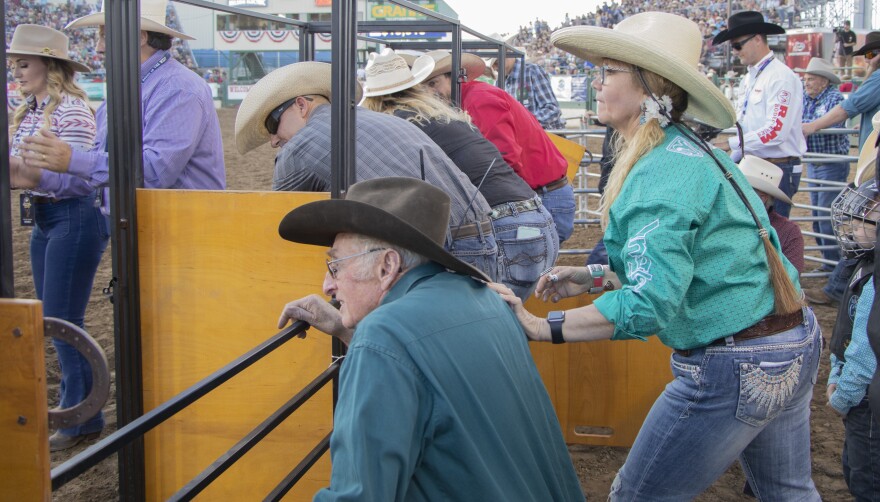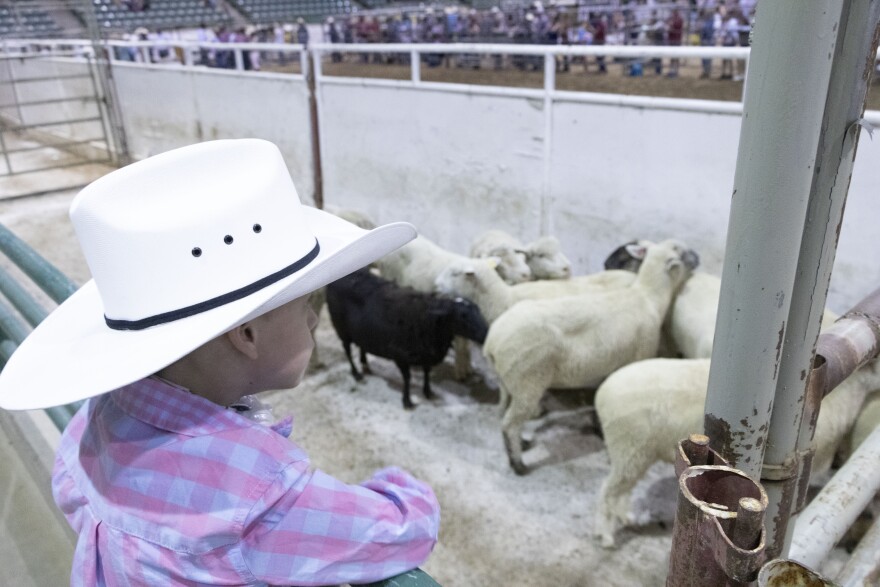Mutton bustin’ is one of the Reno Rodeo’s most popular events. It involves children clinging onto the backs of sheep and trying to hang on, as long as possible. KUNR’s Lucia Starbuck explores what this sport means to those involved.
A volunteer is placing a young rider on the back of an unsheared sheep as mutton bustin’ is about to begin in the arena.
There’s a group of about a dozen pint-sized cowboys and girls decked out in Western gear and black helmets. Dellice Steadman is hustling back and forth along the makeshift chute, ensuring that things are running smoothly.

“I was in the first group of women to come into the Reno Rodeo 25 years ago,” Steadman said.
For a majority of that time, Steadman has been involved with mutton bustin’ and is now the committee chairperson for that event. For her, it’s more than just a volunteer gig.
“I love kids. I was never able to have children, so this way, I get to have 120 children over a 10-day span every year,” Steadman said.
A big part of Steadman’s job is watching over the riders' safety, which is why she tells parents not to push their kids if they're not willing or ready.

Steadman says there haven’t been any major injuries from Mutton Bustin’ recorded at the Reno Rodeo. The kids are required to wear vests and helmets with face masks.
Other precautions include prepping the ground in the arena. She says the dirt is graded, making it fluffy and deep.
“So, it's not like you're landing on a cement slab or, you know, just a dirt road. No, it's pretty cushy, actually. If you're going to fall, yeah, I’d definitely want to fall out there,” Steadman said.
Though, safety is still a concern. Dr. Arthur Islas is the Fellowship Director for Sports and Wilderness Medicine at the University of Nevada, Reno. Every year during the Reno Rodeo, Islas mentors recent med school grads who are there to treat athletes with concussions, sprains and other common injuries.

“So, I get asked this question every year about mutton busting: 'Is mutton busting a dangerous sport?' And the truth is, of course it’s dangerous. You just attached your kid to an animal that's probably twice it's size and the kid’s hanging on for dear life and eventually the kid will fall off. Your child will fall off the mutton. And you worry about about the mutton kicking the child in the head or stepping on the child. You know, most of the time those injuries are pretty benign,” Islas said.
Charlene Norvell has two sons who will participate in the event. She says that her sons run the same risk of injury riding their scooters around the neighborhood. She’s been practicing letting her sons cling on to her back to prepare for getting on a sheep.
One of her sons, Landon, is six years old and was sold on mutton bustin’ when he saw a sheep last year with a name that stuck out to him.
“There was a kid riding Rainbow, so then I wanted to ride Rainbow. That's why I hope Rainbow's in it this year, so I could ride her or him,” Landon said.

Landon is the proud older brother of five-year-old Asher, who will also be competing. Asher was born prematurely and his vocal cords are paralyzed. Their mom says he spent nearly a year of his young life in the hospital and the two boys share a special bond.
“Well, he copies everything his big brother does, so once Landon said he wanted to do it, Asher had to hiss in and say, ‘Yeah, yeah, yeah.’ I was like, okay, cause I promised myself I would never let his disability hold him back from a normal childhood,” Norvell said.
Asher is a smiley young man, who loves animals and has an adventurous side.
“Just with Asher, I was told he may never walk. He may never talk, and here he is playing T-ball, soccer," Norvell explains. "He just overcame everything and is out showing people that. Some people think I should put them in a bubble and protect him, and I never want him to grow up and think, ‘Man, Mommy didn't let me do this because you were afraid.’ ”








